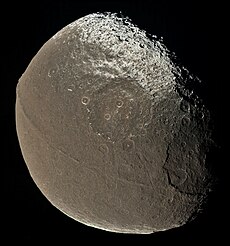 Iapetus's equatorial ridge up close as imaged by Cassini | |
| Feature type | Mountains |
|---|---|
| Location | Iapetus |
| Coordinates | 0°N 0°W / 0°N -0°E |
| Length | 1,300 km (810 mi) |
| Peak | 20 km (12 mi) |
| Discoverer | Cassini |
The equatorial ridge is the tallest mountain feature on Saturn's moon Iapetus. It is 20 km (12 mi) high, and is the third tallest mountain structure in the Solar System. It runs along most of Iapetus' equator. It was discovered by the Cassini probe in 2004. The ridge's origin is unknown. There are bright areas on the sides of the equatorial ridge near Iapetus' bright trailing hemisphere, which were already visible in Voyager 2 images appearing like mountains and were nicknamed the "Voyager Mountains".[1]
![This series of images of Iapetus' north pole by Voyager 2 became the first-ever hints on the existence of the moon's equatorial ridge. The white and grey dots below each images (Iapetus' equator) will later be revealed to be Voyager Montes by Cassini.[10] Taken on August 22, 1981.](https://upload.wikimedia.org/wikipedia/commons/5/5f/Iapetus_Voyager2_flyby_sequence.jpg)
![A global view of Iapetus obtained by the Cassini spacecraft on Dec. 31, 2004 - the first-ever clear image of the ridge - at a distance of about 172,900 kilometers (107,435 miles).[11] The massive structure clearly distorts the shape of the moon at the equator.](https://upload.wikimedia.org/wikipedia/commons/thumb/7/73/Iapetus.jpg/280px-Iapetus.jpg)
![Iapetus' massive equatorial ridge is clearly visible from Cassini's images as the space probe approached Iapetus from its nightside during its closest flyby of the moon on September 10, 2007 at a distance of 83,000 kilometers (51,600 miles). The spacecraft came as close as 1,227 km (762 mi) from the moon's surface during this flyby.[12][13] This is also the clearest picture of the equatorial ridge to date.](https://upload.wikimedia.org/wikipedia/commons/thumb/9/94/Iapetus_crescent_true_color.png/204px-Iapetus_crescent_true_color.png)
